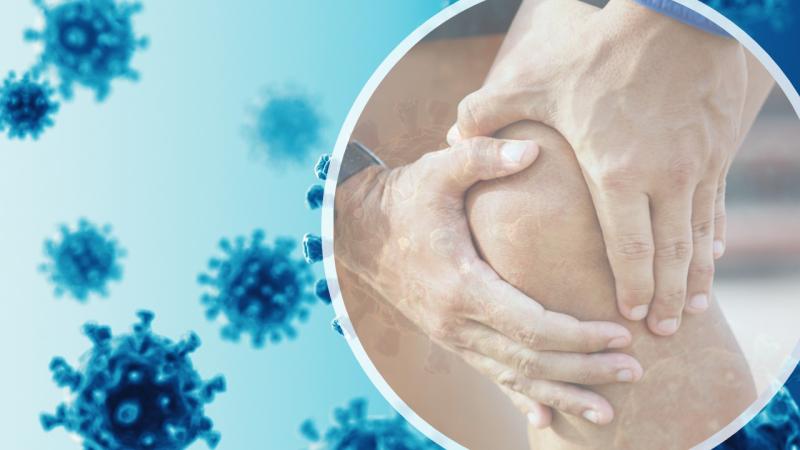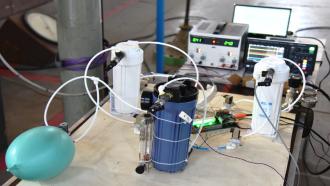
Rheumatoid Arthritis (RA) is a disease that was first described and diagnosed in the 19th century. It affects around 1-2% of the people in the world today. It is called an auto-immune disease as it causes the body’s immune system to attack the body’s own tissues, mainly the joints, instead of invading microbes. A recent review suggests a connection between RA and COVID-19, based on several lines of evidence.
Since March 2020, the SARS-CoV2 virus and the disease it causes, COVID-19, has dominated the news and much of our lives. Two years may have seemed a very long time to the people who have been through the COVID-19 pandemic, but it is still too short a time to know the full medical consequences of the disease. Unlike previous pandemics however, the current one is happening at a time when scientists can obtain large amounts of data quickly and look through them for patterns. This helps doctors and researchers work out how COVID-19 affects the body, why a person may be at a higher risk of catching this disease or dying from it, and perhaps how best to treat it.
A group of researchers from India, Japan and the USA reviewed evidence from many different scientific studies about COVID-19 and RA and put it all together in a systematic review. This review shows that there is growing evidence of a similarity in the way COVID-19 affects the lungs and RA affects the bones and muscles. The review was published in the journal Cells. The study was funded by the Council of Scientific and Industrial Research (CSIR), Department of Biotechnology (DBT), Kakatiya Medical College, and CSIRIICT (Hyderabad) in India; and the National Institute of Health (NIH) in the USA.
Previous systematic reviews from 2020 and 2021 have shown that RA patients are more vulnerable to the SARS-CoV2 infection than other people. The authors of the current study note that COVID-19 is almost twice as prevalent among patients with diseases like RA compared to the general population. As early as April 2020, data from the UK suggested the risk of not just developing COVID-19 but also dying from it was slightly increased in RA patients. More recent studies have held up this finding. RA patients are often in poorer health overall than other people as they often have other health conditions not caused by RA, such as asthma, diabetes and heart disease. COVID-19 patients are also more likely to have these conditions.
The review authors describe three significant similarities in the body’s response to COVID-19 and RA. Firstly, both diseases induce a dysfunctional reaction in immune system cells called T-lymphocytes. In a healthy immune response to a virus, T-lymphocytes can recognise cells that the virus has infected and release chemicals that destroy those cells. T-lymphocytes also produce cytokines which act as chemical messengers to other cells. In the dysfunctional reaction, T-lymphocytes are converted to a state that triggers an excessive release of cytokines. The flood of cytokines causes inflammation, deprives cells of oxygen, and further disrupts the body’s immune responses. In RA, there is no invading virus to attack. Still, T-lymphocytes are nevertheless activated and produce many of the same cytokines produced during a COVID-19 infection, leading to inflammation. Thus, the dysfunctional immune response in both COVID-19 and RA induces an inflammatory response by making many of the same chemical molecules.
A second similarity between RA and COVID-19 affects a series of chemical reactions involving ACE - Angiotensin Converting Enzyme. These conversions are part of a more extensive, complex system called the Renin Angiotensin system (RAS), which helps maintain blood pressure and the balance of electrolytes in the body. ACE converts an enzyme called Angiotensin 1 into another enzyme called Angiotensin 2, and ACE2 converts Angiotensin 2 into Angiotensin 1-7. Angiotensin 2 causes inflammation, and Angiotensin 1-7 protects against it. In both COVID-19 and RA, the conversion of Angiotensin 2 to Angiotensin 1-7 is disrupted, upsetting the balance of the system. Thus, as Angiotensin 2 levels build up in the body, inflammation in the body’s tissues also builds up to harmful levels.
The third similarity between RA and COVID-19 involves another type of immune cell called macrophages. Macrophages attack and eat anything that is not a healthy cell belonging to the body, including cancer cells, cellular debris or foreign bacteria. Similar types of macrophages are found in the lungs and joints of healthy people. But the lung macrophages in COVID-19 patients are similar to those in the joints of RA patients. In other words, the immune system mounts a very similar response to both diseases through the activation of the same types of macrophages.
As COVID-19 and RA seem to affect the body through similar chemical pathways, it follows that the treatment of RA might contain clues to the treatment of COVID-19. However, the authors of the review emphasise that it is too early to say how exactly RA drugs should be used in treating COVID-19.
They caution: “... no direct association has been established between specific RA medication and the COVID-19 development or outcomes.”
The fact that RA patients are at higher risk of catching as well as dying of the SARS-CoV-2 virus is a challenge. Monitoring RA patients by doctors during the current pandemic seems sensible, but RA patients risk catching the virus if they visit hospitals or clinics frequently. Telemedicine and virtual monitoring are emerging as promising solutions. In India, doctors are beginning to use methods of virtual care, such as video consultations and emails. While the increased risk of COVID-19 to RA patients needs careful management in the short term, uncovering the biochemical pathways common to both diseases could lead to better treatments for COVID-19.






